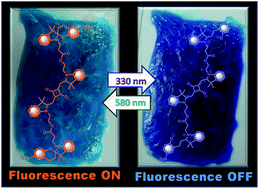Photo-driven near-IR fluorescence switch: synthesis and spectroscopic investigation of squarine-spiropyran dyad†
Abstract
With the objective of developing near-infrared fluorescence switch molecules for potential applications, synthesis of new dyad with two methyl 3-(3′,3′-dimethyl-6-nitrospiro[chromene-2,2′-indolin]-1′-yl)propanoate (6), spiropyran (SP), units as the photochromic acceptors and a near-infrared fluorescence probe, (E)-4-((1-(2-hydroxyethyl)-3,3-dimethyl-3H-indol-1-ium-2-yl)methylene)-2-((E)-(1-(2-hydroxyethyl)-3,3-dimethylindolin-2-ylidene)methyl)-3-oxocyclobut-1-en-1-olate (SQ), (3) as fluorescent donor are described. Two SP units are attached to the two indole nitrogen of squarine core with almost no conjugation with the SQ unit. The spectroscopic properties of the newly synthesized dyad, SP–SQ–SP(7), and corresponding model compounds (SP, SQ) have been studied in acetonitrile solution, poly(ethylene glycol) (PEG) polymer matrices and in nanoparticle form dispersed in aqueous medium. These dyes (3 and 7) exhibited absorption in the range 550–670 nm, with significant absorption coefficients (10−5 M−1 cm−1) in the ACN. The fluorescence emission spectra of these dyes cover very broad range from 630 to 750 nm and fluorescence quantum yields are of the order of 0.2 in ACN solution. External stimulations (ultraviolet light and visible light) generate reversible changes in the structure of 7, resulting in changes in the absorption spectra due to the presence of the two spiropyran units. The absorption spectrum of the MC, a ring open form of SP, in dyad SP–SQ–SP(7) has large spectral overlap with the fluorescence spectrum of the SQ unit. Thus, the fluorescence intensity of dyad 7 is modulated by reversible conversion among the two states of the photochromic spiropyran units and the fluorescence resonance energy transfer (FRET) between the MC form and the SQ unit. High-contrast “on/off” fluorescence switching is successfully achieved with remarkably fatigue resistance in solution, in polymer film and in nanoparticle form of dyad (7). The described results indicate that this system may represent an efficient fluorescent switch molecule in potentially rewritable high-density optical data or image storage utilizing near-infrared luminescence intensity readout schemes.


 Please wait while we load your content...
Please wait while we load your content...